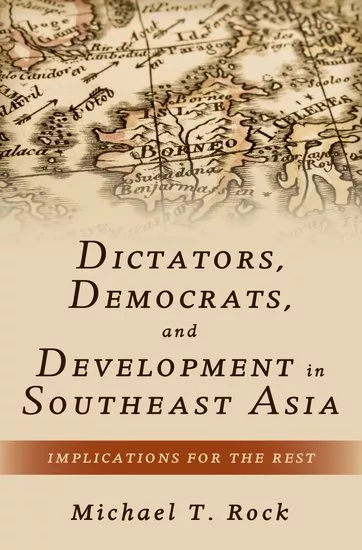Professor of Economics Michael Rock on 'Dictators, Democrats, and Development in Southeast Asia'
Since 1995, Rock says, he’s been thinking and writing about how Indonesia, Malaysia and Thailand managed to succeed at both development and democracy.
At first he turned to political science and economics for the answers, “but they were saying quite different things about these countries,” he says. Until recently, political scientists viewed political elites in these countries as uninterested in development or democracy and more interested in using their positions for personal gain. Economists tended to emphasize the degree to which governments followed the policy nostrums of the Washington consensus—to stabilize, privatize and liberalize.
Rock now says both sides missed the real story of how political elites in these countries used selective interventions and corruption to grow their economies while enriching themselves and those in their patronage networks.
Why did you decide to focus on Indonesia, Malaysia and Thailand—or IMT as you call them in the book?
If you look at growth rates in the developing world since 1960, there are only nine countries that have been able to sustain high growth over this period of time. That means that more than 90 percent of all developing countries have had a difficult time sustaining even decent growth rates, let alone high ones. As a result, most of the developing world is not catching up to the developed world. Rather, they are falling behind. Or to quote Lant Pritchett of Harvard, we are experiencing ‘divergence big time.’
Of the high growth countries, almost half of them are in northeast Asia: Japan, Korea, Taiwan and China. But their politics, bureaucratic institutions, and their ethnic homogeneity is so different from the rest of the developing world that there’s not much that the rest of the developing world can learn from them. Then there are a couple of small and fast growing countries in the Middle East (Oman) and southern Africa (Botswana). There’s not much the rest of the developing world can learn from them, either.
But three of these countries—Indonesia, Thailand and Malaysia—have a lot of conditions that are very similar to the rest of the developing world.
What are those conditions?
They tend to be natural resource-rich, they tend to have substantial ethnic diversity, they tend to have governments and bureaucracies that are pretty weak, and they tend to be prone to corruption. Those are conditions that are similar to much of the rest of the developing world that’s trying to grow and hasn’t been very successful. I thought, well, maybe these countries with conditions that are similar to the rest might have something to say to the rest. That’s why I wrote the book.
And what did you discover? How did IMT succeed in developing when so many other countries haven’t yet?
To begin with, sustained growth in IMT did not occur until political elites completed nation-building projects that created clear winners (a center right coalition consisting of monarchies, bureaucratic elites, the military and business elites) and clear losers (the Left, popular groups in civil society and religious fundamentalists) enabling the winners to define what it meant to be an Indonesian, a Malaysian, or a Thai. Nation-building in IMT was a long, drawn out, and contentious project rooted in violence and recurrent crises.
Were there commonalities between the groups that won?
In each of these countries, the groups that won tended to be politically and socially conservative, pro-capitalist, and pro-private property. They viewed capitalism as necessary to grow the economy, but they did not believe in laissez faire economic policies. They favored open economy policies too, but not laissez faire or free trade and investment policies. They were also committed to interventionist policies to industrialize and diversify their economies away from the production and export of primary products such a sugar, spices, tin, rubber and rice. The winners were very pragmatic and non-ideological.
When markets worked, governments relied on them. When interventions in markets worked, governments did not shy away from using them. When either failed to achieve desired results, governments searched for pragmatic alternatives. This pragmatic and non-ideological approach to development carried over into the democratization process as old and new political elites captured this process so that they could engineer the creation of centripetal democracies so they could sustain their pro-growth political coalitions and their pro-growth economic and industrial policies. So far, this interventionist political strategy worked as high growth has been sustained following democratization.
What else might surprise people reading this book?
One thing is that, despite high corruption, these countries were able to grow very fast for over 50 years. Most people think corruption is bad for growth, and in most places in the world it is. But if it’s structured in a certain way, it can actually be good for growth.
How did corruption help IMT grow?
There are several aspects of the growth and corruption story in IMT. First, governing political elites came to see development in their long run political interest. Because of this they were willing to provide the public goods and public policies to get growth going. But these same political elites needed funding to finance their patronage networks, win elections, and enrich themselves. They also needed to create a capitalist class to grow the economy. Through trial and error and sometimes dumb luck, they came to realize that if they showered government promotional privileges—tax breaks, subsidized credit, preferential access to foreign exchange, duty free imports and monopoly privileges—on a small number of capitalists they could exchange promotional privileges for kickbacks. In this arrangement, IMT’s crony capitalists grew the economy while also providing political elites with the resources they needed to sustain their patronage networks and win elections.
This corrupt deal could have failed if political elites took too much or crony capitalists failed to grow the economy. Neither happened. Political elites did not take too much because they had monopoly control of corruption networks and because they got what they needed by taking it out of the capitalists’ growth dividend. The capitalists in IMT, who were a scorned Chinese minority, grew their businesses and the economy while kicking back a share of their profits because doing so was better than the alternatives—facing discrimination by the state or leaving the country.
What lessons should other developing countries take from IMT?
There are a host of lessons that I go into detail about in the book. Here are the most important ones: The first is that growth and development do not happen until a country completes the nation-building project that creates clear winners and losers. The second is that the winners need to use their control over the state and their conservative predispositions to pursue a more or less coherent, largely trial and error, and pragmatic growth strategy that emphasizes a capitalist, but not free market, industrial and open economy, but not free trade, approach to growth and development. The third is to recognize that this strategy can work because it is economically viable, because it can meet the long run interests of governing elites and because political elites put in place mechanisms to weed out bad investments and poor policy choices. The fourth is that even though popular groups were locked out of politics, they weren’t ignored. In fact, governments in IMT adopted a variety of second-best economic policies to reward, placate and co-opt popular groups so they could sustain high growth. One result of this is that growth in IMT has been quite equitable and poverty reducing. Finally, the success of this strategy is likely to spawn democratization and unless political elites capture the democratization process and structure new democratic institutions so they can sustain their pro-growth coalitions, growth might falter. Because political elites in IMT were able to do this, they have been able to sustain high growth.
Which countries do you think may follow in IMT’s footsteps next?
I wrote the book with countries with similar conditions in mind—those with multi-ethnic populations, high levels of corruption, weak bureaucracies and weak governments—especially those in sub-Saharan Africa such as Nigeria, Ghana, and Kenya, among others.
And what do you see in the future for Indonesia, Malaysia and Thailand?
One of the biggest problems they face is that they haven’t been very good at technological upgrading. That’s one of the things that distinguishes them from Korea, Taiwan, Japan and China. .
Because of this, they’ve probably come close to reaching the end of the growth strategy that they’ve adopted and unless they become better at technological catch up, growth is likely to slow. To do so, their educational institutions have to get better, they need to create national innovation systems, they need to provide incentives for domestic firms to borrow, adapt and improve upon foreign technologies, and they’re not really good at that yet.
It hasn’t hurt them yet—largely because they have rich natural resource bases and because they’ve been good at accumulating capital—but they’re going to have to figure out how to engage in technological catch up. My view is that they’re probably pragmatic enough and they’ll figure it out. No one gave them the chance to succeed the way they’ve succeeded after 1965, so I tend to be an optimist about this.
Do you have a next project? If so, what is it?
I’m working on a new book project titled Democracy, Development and Islam. I’ve been intrigued by the political and economic successes of Indonesia and Malaysia, two majority Muslim countries and I’d like to compare them with similarly placed others in the Muslim world. I spent the summer reading about Egypt and Turkey and I’m working on a comparative essay that will hopefully be the foundation of this book.
What I’ve learned so far is that the so-called Muslim democracy gap is essentially an Arab, not a Muslim gap. The same holds for the so-called Muslim development gap, it is largely, but not only, an Arab gap. I’ve begun to explore why this is so. So far two things are clear. First, many of the Arab countries, like Egypt, adopted a populist-socialist development strategy that simply can’t and didn’t work. So far nothing has been put in its place and the Egyptian economy continues to flounder. Second, the failure to deliver development; the inability to come up with an alternative and viable development project; and the weakness of liberal democratic forces has left opposition politics open to radical Islam such as the Muslim Brotherhood in Egypt. Nothing like this has occurred in either Indonesia or Malaysia.

